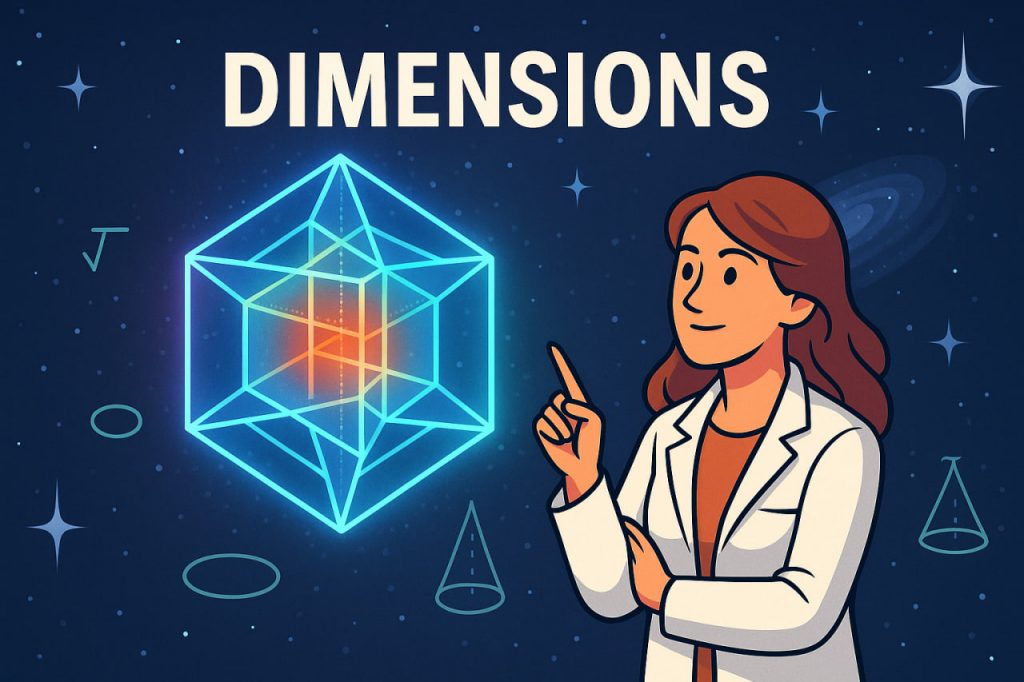From the three-dimensional world we perceive daily to the unseen realms theorized by physics, dimensions are the framework of existence. They define how we move, interact, and experience reality. While we intuitively understand length, width, and height, scientists have discovered that the universe may be composed of far more than just these familiar three. Exploring the nature of dimensions is not only a journey through science but also a profound reflection on the limits of human perception and imagination.
The Three Dimensions of Space
In everyday life, we exist in three spatial dimensions:
- Length (x-axis) – forward and backward.
- Width (y-axis) – left and right.
- Height (z-axis) – up and down.
Together, they form the physical space in which all objects and beings exist. Our brains are wired to navigate and interpret this 3D environment, allowing us to measure distance, shape, and structure. Artists, engineers, and architects rely on this spatial awareness to create and understand the material world. Yet, these three dimensions are just the beginning of a much deeper cosmic structure.
The Fourth Dimension – Time
The concept of a fourth dimension was introduced by physicist Albert Einstein through his Theory of Relativity. He proposed that time is inseparably linked to the three dimensions of space, forming a unified framework called spacetime. In this model, massive objects like planets and stars warp spacetime around them, creating gravity. This means time is not constant—it bends and stretches depending on speed and gravity. Astronauts aboard the International Space Station, for example, experience time slightly slower than people on Earth, a phenomenon known as time dilation. Thus, time is not merely a ticking clock but a dimension woven into the very fabric of reality.
Higher Dimensions in Physics
Beyond spacetime, theoretical physicists have proposed that the universe may consist of 10 or even 11 dimensions. In String Theory and M-Theory, all particles are tiny vibrating strings that exist within multiple hidden dimensions. These extra dimensions are curled up at microscopic scales, invisible to human senses or current technology. They could explain the mysteries of gravity, quantum mechanics, and the fundamental forces of nature. While these ideas remain unproven, they offer a tantalizing glimpse into a universe far more complex than we can perceive.
Dimensions Beyond Physics – The Multiverse Hypothesis
Some cosmologists suggest that higher dimensions might contain parallel universes—alternate realities existing side by side with ours. This idea, known as the Multiverse Hypothesis, proposes that our universe is just one bubble in an infinite cosmic foam. Each universe could have its own laws of physics, time flow, and even versions of ourselves. Though currently speculative, quantum mechanics supports this possibility through the Many-Worlds Interpretation, which suggests that every quantum event spawns multiple outcomes in separate dimensions. The multiverse theory challenges our understanding of reality itself, blurring the line between science and philosophy.
Perception and the Limits of Human Senses
Humans perceive only a small fraction of reality. Our senses are tuned to three dimensions, but that doesn’t mean others don’t exist. Just as a two-dimensional being (living on a flat surface) could not comprehend height, humans might be blind to higher-dimensional spaces that exist all around us. Mathematicians use projections and geometry to model these dimensions, such as the tesseract—a four-dimensional analogue of a cube. Artists and philosophers have used this idea to explore new ways of visualizing and understanding the infinite.
Dimensions in Philosophy and Spirituality
Throughout history, the concept of dimensions has appeared in spiritual and metaphysical teachings. Ancient mystics and philosophers spoke of multiple planes of existence—physical, mental, and spiritual. Modern thinkers often interpret higher dimensions as symbolic representations of consciousness or alternate states of being. While science and spirituality approach the concept differently, both seek to uncover what lies beyond ordinary perception, suggesting that reality might be layered with meaning as well as matter.
Expert Perspectives
According to theoretical physicist Dr. Brian Greene, “Dimensions are nature’s way of hiding her deepest secrets.” Similarly, Dr. Michio Kaku explains that extra dimensions may hold the key to a unified “Theory of Everything,” connecting gravity, quantum mechanics, and the forces of the universe. Cognitive scientists also point out that human perception is inherently limited—our brains simplify reality into manageable forms, leaving much of the universe unseen and unexplored.
The Future of Dimensional Research
Advances in quantum computing, gravitational wave detection, and particle accelerators may one day reveal evidence of higher dimensions. Scientists at CERN’s Large Hadron Collider are already testing theories that predict “leakage” of energy into other dimensions. If confirmed, such discoveries could revolutionize physics, leading to new energy sources, deeper understanding of consciousness, and even interdimensional travel—once confined to the realm of science fiction.
Interesting Facts
- According to String Theory, the universe could have 10 spatial dimensions plus time.
- A tesseract is a geometric representation of a four-dimensional cube.
- Gravity might be weak because it “leaks” into higher dimensions.
- In Einstein’s relativity, time slows down near massive objects like black holes.
- The Multiverse Theory suggests infinite universes may exist beyond our own.
Glossary
- Spacetime – The four-dimensional continuum combining space and time.
- Time Dilation – The slowing of time under high speed or strong gravity.
- String Theory – A theoretical framework suggesting all particles are vibrating strings in higher dimensions.
- M-Theory – An extension of string theory proposing 11 dimensions.
- Tesseract – The four-dimensional version of a cube.
- Multiverse – A hypothetical collection of multiple universes existing simultaneously.
- Event Horizon – The boundary around a black hole beyond which nothing can escape.
- Quantum Mechanics – The branch of physics dealing with subatomic particles.
- Projection – A mathematical method of representing higher dimensions in lower-dimensional space.
- Theory of Everything – A proposed unifying theory linking all physical forces in nature.


